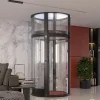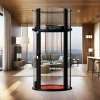Elevators are essential components of modern buildings, providing a reliable means of vertical transportation. However, like any mechanical system, elevators can experience issues over time. Professional maintenance is crucial for addressing these common problems and ensuring the smooth operation of elevators. This article explores frequent elevator problems and explains how professional maintenance can effectively resolve them.
Common Elevator Problems
- Unresponsive Controls:
- Problem: Passengers may find that the elevator buttons do not respond, leading to delays and frustration.
- Cause: Issues with the control panel, faulty wiring, or malfunctioning switches can cause unresponsive controls.
- Door Malfunctions:
- Problem: Doors may fail to open or close properly, or they may get stuck halfway.
- Cause: Problems with door operators, sensors, or tracks can lead to door malfunctions.
- Jerky or Rough Ride:
- Problem: Passengers experience a jerky or uneven ride, which can be uncomfortable and concerning.
- Cause: This issue is often due to worn-out cables, pulleys, or misaligned components.
- Noise and Vibration:
- Problem: Excessive noise or vibration during operation can indicate underlying issues.
- Cause: Noisy elevators are usually caused by worn bearings, misaligned components, or issues with the drive system.
- Emergency Communication Failure:
- Problem: The emergency communication system may not work, which is critical for passenger safety.
- Cause: Faulty wiring or malfunctioning components can lead to failure in emergency communication systems.
- Overloading Issues:
- Problem: Elevators may experience problems when overloaded, including failure to operate or abrupt stops.
- Cause: Problems with the load sensors or control systems can lead to incorrect overload detection.
- Lighting Problems:
- Problem: Poor or non-functional lighting inside the elevator cabin can affect visibility and safety.
- Cause: Issues with the lighting fixtures or electrical connections are often responsible.
How Professional Maintenance Solves Elevator Problems
- Comprehensive Diagnostics:
- Problem Identification: Professional maintenance technicians conduct thorough diagnostics to accurately identify the root causes of elevator problems.
- Advanced Tools: Technicians use specialized tools and equipment to assess and troubleshoot issues effectively.
- Control System Repairs:
- Component Replacement: Technicians replace or repair faulty controls, wiring, and switches to restore proper functionality.
- System Calibration: Adjustments and recalibrations ensure that the control system operates smoothly and reliably.
- Door Mechanism Repairs:
- Operator Servicing: Professional maintenance includes servicing or replacing door operators and sensors to ensure smooth operation.
- Track Alignment: Technicians realign tracks and adjust door mechanisms to prevent sticking and jamming.
- Ride Quality Improvement:
- Component Replacement: Worn-out cables, pulleys, and bearings are replaced to improve ride quality and reduce jerky movements.
- System Adjustments: Technicians fine-tune the drive system and alignment to enhance the smoothness of the elevator ride.
- Noise and Vibration Reduction:
- Bearing Replacement: Worn bearings and other noisy components are replaced to reduce vibrations and noise.
- Alignment and Lubrication: Proper alignment and lubrication of moving parts help minimize operational noise.
- Emergency System Maintenance:
- Component Testing: Emergency communication systems are tested and repaired to ensure they function correctly during emergencies.
- Wiring Checks: Technicians inspect and repair wiring to maintain the reliability of emergency systems.
- Load Sensor Calibration:
- Sensor Testing: Load sensors are tested and calibrated to ensure accurate detection of load limits and prevent overloading.
- Control System Adjustments: Adjustments to the control system help manage load limits and prevent operational issues.
- Lighting Repairs:
- Fixture Replacement: Faulty lighting fixtures are replaced to restore proper illumination within the elevator cabin.
- Electrical Repairs: Technicians repair electrical connections to ensure consistent and reliable lighting.
Benefits of Professional Maintenance
- Enhanced Safety:
- Preventive Measures: Professional maintenance helps prevent accidents and ensures elevators meet safety standards.
- Reliable Operation: Regular maintenance reduces the risk of unexpected failures and ensures reliable elevator operation.
- Improved Performance:
- Smooth Operation: Addressing common issues leads to a smoother and more efficient elevator performance.
- Increased Lifespan: Regular maintenance extends the lifespan of elevator components, reducing the need for costly replacements.
- Cost Efficiency:
- Reduced Repair Costs: Identifying and addressing problems early can prevent more severe issues and reduce overall repair costs.
- Minimized Downtime: Professional maintenance helps ensure elevators remain operational and minimizes service disruptions.
- Enhanced User Experience:
- Comfort and Convenience: Proper maintenance provides a comfortable and reliable transportation experience for users.
- Increased Satisfaction: Well-maintained elevators contribute to higher satisfaction levels among building occupants.
Conclusion
Common elevator problems, such as unresponsive controls, door malfunctions, and noise issues, can significantly impact the safety and performance of elevator systems. Professional maintenance plays a crucial role in diagnosing, repairing, and preventing these issues. By investing in regular maintenance and expert services, building owners and managers in Dubai can ensure the safe, efficient, and reliable operation of their elevator systems, ultimately enhancing the user experience and extending the lifespan of their equipment.








